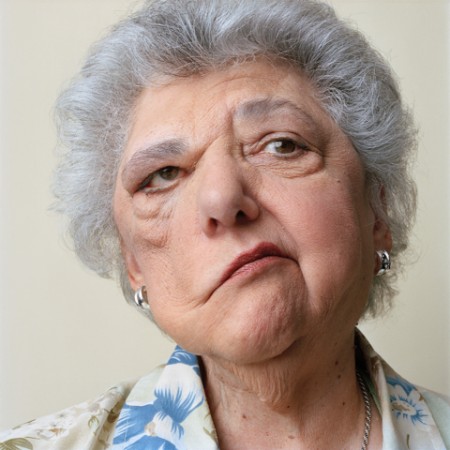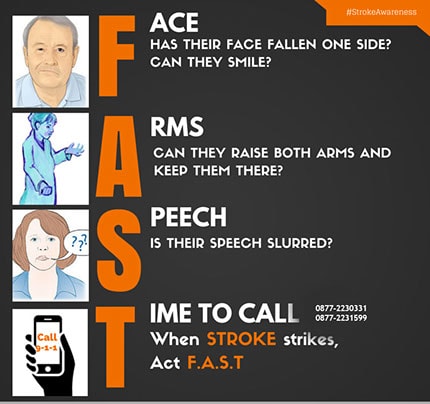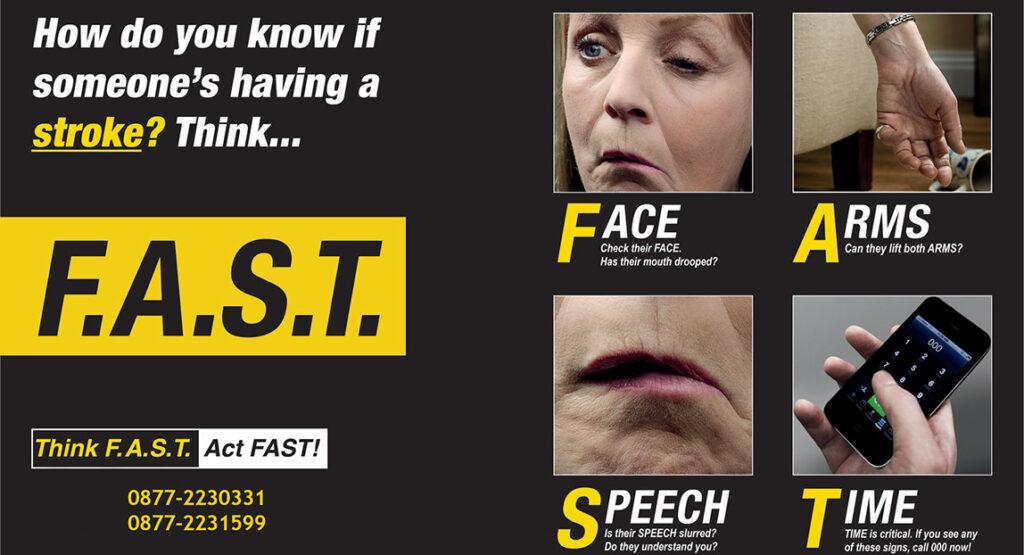
Strokes are one of the leading causes of death and disability worldwide, affecting 15 million people worldwide every year. It is the second biggest cause of death among elderly citizens over sixty.
Strokes happen when either a blood vessel in the brain suddenly ruptures (Hemorrhagic stroke), or a blood clot blocks blood supply to parts of the brain (Ischemic stroke).
Often, before a major stroke, patients experience transient ischemic attacks (TIA) or “Mini-Strokes”. This happens when the brain is temporarily deprived of oxygen because of a drop in blood supply. Symptoms typically last only a few minutes. However, seek medical attention immediately. Timely medical intervention can prevent a full-blown stroke later.


The paralysis is usually on the side of the body opposite the side of the brain damaged by stroke and may affect the face, an arm, a leg, or the entire side of the body. This one-sided paralysis is called hemiplegia (one-sided weakness is called hemiparesis).

Paralysis or the inability of a muscle to move is one of the most common disabilities resulting from stroke. As many as 9 out of 10 stroke survivors have some degree of paralysis immediately following a stroke. Continued rehabilitation and therapy can help stroke survivors regain voluntary movement even years following their stroke.
Paralysis is the inability of a muscle or group of muscles to move voluntarily. Muscles are controlled by messages sent from the brain that trigger movement. When part of the brain is damaged by a stroke, messaging between the brain and muscles may not work properly.
Paralysis is usually on the side of the body opposite the side of the brain damaged by stroke and may affect any part of the body. You may experience one-sided paralysis, known as hemiplegia, or one-sided weakness, known as hemiparesis. Locked-in syndrome is an example of severe paralysis that leaves the stroke survivor unable to move any muscles except those that control the eyes.
Post-stroke paralysis symptoms may include but are not limited to:
What is a brain stroke?
A stroke occurs when the blood supply to your brain is interrupted or reduced. This deprives your brain of oxygen and nutrients, which can cause your brain cells to die. A stroke may be caused by a blocked artery (ischemic stroke) or the leaking or bursting of a blood vessel (hemorrhagic stroke).
How does a stroke affect the brain?
If the stroke occurs on the left side of the brain, the right side of the body will be affected, producing some or all of the following: Paralysis on the right side of the body. Speech/language problems. Slow, cautious behavioral style.
What are the side effects of a stroke?
While each stroke is different—depending on the part of the brain injured, the severity of the injury, and the patient’s general health—there are some common after-effects. Weakness (hemiparesis—hem-ee-par-EE-sis) or paralysis (hemiplegia—hem-ee-PLEE-ja) may affect one whole side of the body, or just an arm or leg.
Right Brain
If the stroke occurs in the right side of the brain, the following:
Left Brain
If the stroke occurs on the left side of the brain, the right side of the body will be affected, producing some or all of the following:
DRUGS
Drugs like Aspirin or a tissue plasminogen activator (TPA) to break down clots and prevent further ones from forming.TPA is very effective but needs to be injected within 4.5 hours of stroke symptoms.
HEMORRHAGIC STROKE
A brain aneurysm burst or a weakened blood vessel leak (hemorrhagic) is one of two types of stroke. While the least common of the two types of stroke it most often results in death.
ISCHEMIC STROKE
A blood vessel carrying blood to the brain is blocked by a blood clot (ischemic) is one type of stroke. Learn more about the types of ischemic stroke.
WHAT IS TIA?
When blood flow to part of the brain stops for a short period of time, also called transient ischemic attack(TIA),it can mimic stroke-like symptoms. These appear and last less than 24 hours before disappearing. Learn more about the signs,your risk,and TIA management.
***We Promise, no spam!
Andhra Pradesh Most Advanced Neuro Treatment
Services,At Sri Padmavathi Multi-Specialty Hospital
providing the latestand most advanced treatment
modalities.
© 2021, Sri Padmavathi Hospital. All Rights Reserved.